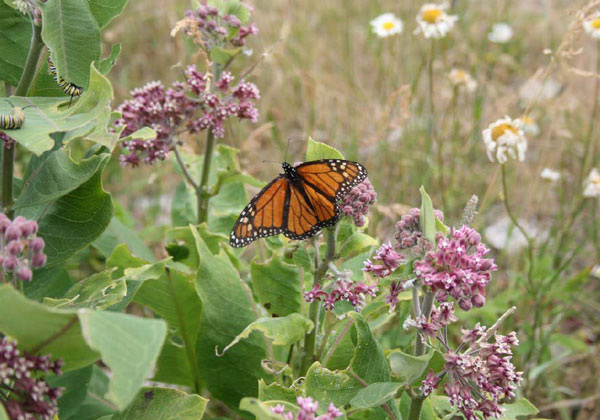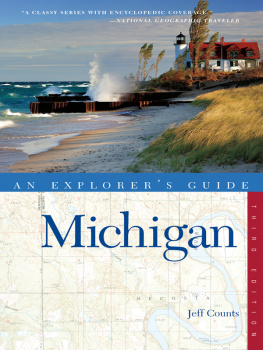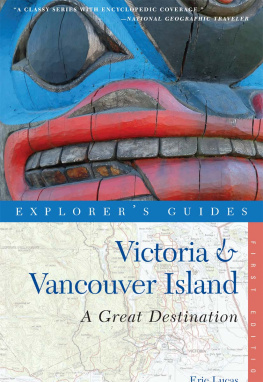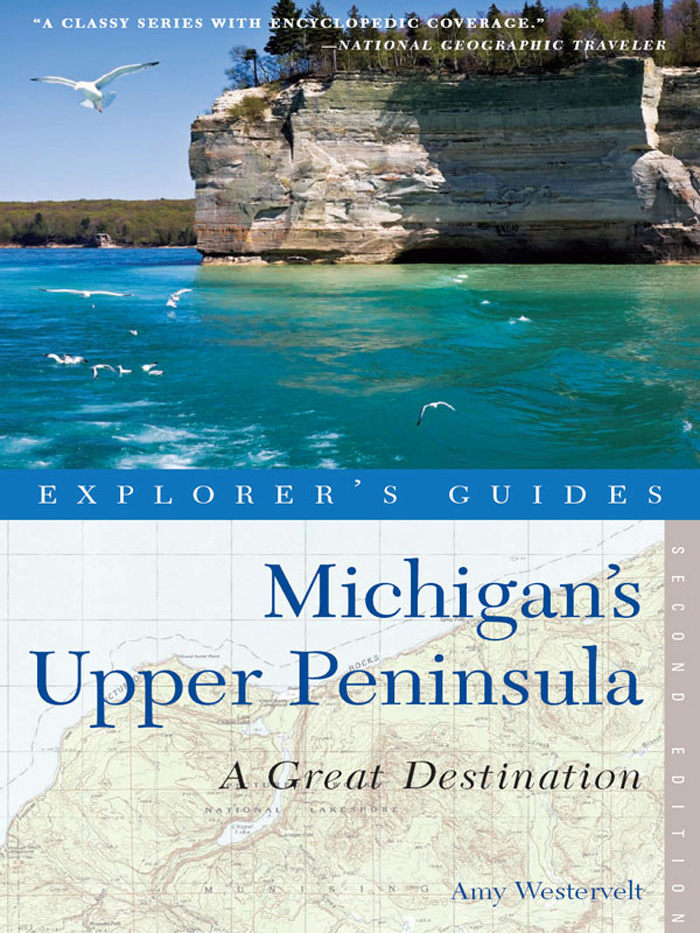EXPLORERS GUIDES
Michigans
Upper Peninsula


Copyright 2012 by Amy Westervelt
All rights reserved. No part of this book may be reproduced in any form or by any electronic or mechanical means including information storage and retrieval systems without permission in writing from the publisher, except by a reviewer, who may quote brief passages.
Explorers Guides Michigans Upper Peninsula, A Great Destination
ISBN 978-1-58157-138-7
Interior photographs by the author unless otherwise specified
Maps by Erin Greb Cartography, The Countryman Press
Book design by Joanna Bodenweber
Composition by Eugenie S. Delaney
Published by The Countryman Press, P.O. Box 748, Woodstock, VT 05091
Distributed by W.W. Norton & Company, Inc., 500 Fifth Avenue, New York, NY 10110
Printed in the United States of America
10 9 8 7 6 5 4 3 2 1
This book is dedicated to the people of the U.P.
Would that more people shared your kindness,
honesty, and community spirit!

Acknowledgments
ALTHOUGH THE FORMAT HAS CHANGED A BIT , the first edition of this book is the foundation for this updated edition, and all the people I thanked the first time around are still deserving of gratitude: my husband, parents, brother, and, of course, all my lovely Yooper friendsthe nicest, most sincere group of people Ive come across, particularly Mrs. Donna Weigel. I am also indebted to Michaelanne Petrella for helping to check my facts, Kim Grant for giving me the opportunity to write this book in the first place, Lisa Sacks for dealing with all the editing and coordinating of this edition, and Kermit Hummel and Countryman Press for publishing it.
LEFT: Tucked away in a hemlock forest, Sable Falls are among the U.P.s most picturesque. Matt Girvan

Introduction
WHEN I ARRIVED IN MICHIGAN FROM CALIFORNIA , I expected snow and lakes and friendly midwesterners. What I did not expect was that, having traveled the world from Brazil to Italy, Morocco to Jordan, I would find one of my all-time favorite vacation destinations here: the Upper Peninsula.
As Ive been telling friends and family for years, the U.P. is one of the best-kept secrets in America. In the summer, swimmers, kayaks, small pleasure boats, and yachts skim across crystal-clear lake waters; cyclists ride through mountains and woods or take it easy closer to shore, enjoying the views; hikers find indescribably beautiful waterfalls and rock formations, not to mention an incredible variety of birds and wildlife. In fall, leaves turn from green to gold to fiery orange and bright red, rivaling the famous fall foliage of New England. In the winterOK, in the winter it is freezing cold in the U.P., but you know what? Its still beautiful. The snow is always white and soft; theres none of that dirty, salty city snow up here. Cross-country skiers have mile after mile of wide-open or woodland snow at their disposal, and even with all those skiers, theres enough room for snowmobilers to tear it up for miles without anyone telling them to keep it quiet or slow it down. And theres no need to forgo the fishing in winter. Ice fishing for walleye, whitefish, and trout is great fun, and the lakes freeze up enough by mid-December. When the ice begins to melt and leaves begin to sprout on the trees, April marks the start of trout-fishing season, and its hard to imagine a better place to watch the magic of spring. Lilac runs riot over the islands, cherry blossoms explode with color, and birds sing cheerful tunes along the shore and in the woods. Though summer is warm and lovely, it is the only time of the year when crowds form in certain parts of the U.P. (Mackinac, Pictured Rocks). For those who prefer to avoid crowds, I recommend heading up in the spring, just after the first blooms (April and May) but before the summer crowds, or in September when the crowds have left but the sun is still shining and the leaves are just starting to turn.
LEFT: The coastline near Grand Marais is some of Lake Superiors most beautiful. Matt Girvan

In spring, the U.P. is awash in wildflowers. Matt Girvan
No matter what time of year it is, visitors are always treated to a warm, friendly Yooper welcome. (Yooper is slang for locals in the U.P. and comes from U.P.-er). People still wave hello to strangers, and although there are certain local treasures that residents are hesitant to share, most are happy to show off their home by pointing visitors in the direction of the best local sights and eats. Perhaps even more important, they have no problem steering tourists away from sights that arent what theyre cracked up to be.
My goal is that this guide be your own personal Yooper traveling companionfriendly and knowledgeable, pointing you toward secret waterfalls and charming B&Bs, romantic dinner spots, and the best piping-hot pasties, all while entertaining you with ancient legends and juicy bits of modern history.
The Way This Book Works
MICHIGANS UPPER PENINSULA is larger than the four states of Connecticut, Delaware, Massachusetts, and Rhode Island combined, with a continuous 1,700-mile shoreline provided by Lakes Superior, Michigan, and Huron. Within these boundaries, the 384-mile-long peninsula stretches from Drummond Island in the east to Ironwood in the west, reaching 233 miles wide from Menominee in the south to Copper Harbor at the tip of the Keweenaw Peninsula.
Its a lot of territory to cover. In the first edition of this book, we used the Great Lakes as a navigation system. This time around, because Ive learned more about how people use this guide, its divided by region and split into smaller chapters that group popular attractions together. The regional chapters move from east to west, and there are eight chapters total: History; Transportation; The East (Tahquamenon, Mackinac, and the Soo Locks); South Central (Beaches, Ghost Towns, Big Spring, Escanaba, and Manistique); North Central (Pictured Rocks and Marquette); Southwest (Iron Country and the Porkies); Northwest (Houghton, Keweenaw, and Isle Royale); and Information.
The first two chapters of this book cover the intriguing history of the U.P., from Native American tribes to French fur trappers to British and American soldiers, and transportationgetting to and getting around this large region. Then, within each regional chapter, youll find a brief characterization of the region and what to expect when you visit, both in summer and in winter (a very important distinction!), along with recommendations for lodging, dining, shopping, and activities.
It is important to remember that the U.P. has many more trees than people and several more miles of isolated wilderness than developed civilization, so there will be some areas with limited lodging and dining options. Other areas, like Mackinac Island and its environs, are major tourist destinations with plenty of restaurants and resorts to choose from. Another important fact to keep in mind: Winter is considered the off-season in the U.P., which means that a restaurant that was full of diners in June may well be boarded up in December. Some innkeepers shut their doors as well, and even those that remain open are surprised to hear from tourists outside the main season (May through September). Many establishments that stay open for the majority of the year tend to take the month of April off. All of which is to say, a spontaneous trip to the U.P. might not be the greatest idea between December and May, but with a little planning, youll be just fine.









